Skipton Castle
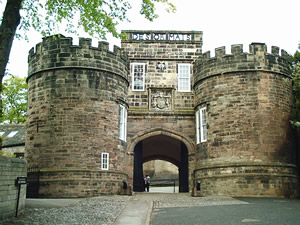
The round towered gatehouse [Enlarge]
View Map (SD 995 519): Multimap | Google | Live Local
Skipton Castle, situated on a cliff above the Eller Beck, was founded circa 1090 by Robert de Romille but, although some Norman masonry is incorporated, what remains now is due to the Clifford family, beginning with Robert de Clifford, who received Skipton in 1310. Robert began to remodel the castle but this work was probably still incomplete when he was killed at the battle of Banockburn in 1314. It was continued by his son, Roger.
Skipton stood for the loyalists during the civil war, finally surrendering in December 1645 after a three year long siege (the last northern stronghold to hold out for the king). The castle was slighted but not badly and the damage was made good around 1657–8 by Lady Anne Clifford.
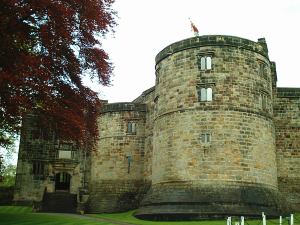
Two of the inner curtain towers and the entrance obscured by the Tudor porch. [Enlarge]
Although the castle originally had an outer bailey there is not much remaining of this other than the outer gatehouse. This twin drum towered structure was part of Robert's castle but was later remodelled by Lady Anne. She it was who added the Clifford motto Desormais (Henceforth). The inner curtain forms the main part of the extant castle. This thick curtain almost takes the form of a shell keep, its D-shape being of small circumference and enclosing a small motte. Today a 1535 Tudor range added by the Earl of Cumberland (and still occupied) runs off from this small inner bailey. This range actually terminates in a octagonal tower which once formed part of the outer bailey defences. A Tudor porch also partly obscures the entrance through the inner curtain, which once was reached by a bridge across a moat and still has visable grooves for a portcullis. This entrance is flanked by two of the six round towers which protect the curve of the D (the northern flat part runs parallel to the cliff and so needs no such protection). The entrance passageway incorporates a round-headed Norman archway but otherwise the enclosure is Edwardian. Curtain and towers all rise from a huge plinth designed to protect against mining of the walls.
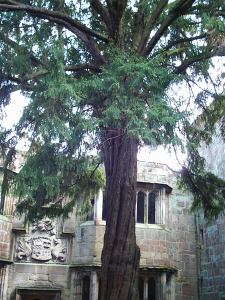
The yew tree planted by Lady Anne Clifford in the picturesque Conduit Court. [Enlarge]
Within the curtain the main feature of the inner castle is the delightful "Conduit Court", which contains a yew tree planted by Lady Anne in 1659. The court is surrounded by domestic accommodation. Against the north curtain is a block with kitchen, hall and solar above undercrofts. The east wing has twin bay windows added by Henry Clifford (the "Sheppard Lord"), who also added further additional windows to the courtyard. Further accommodation was supplied in the towers. The tops of these towers were rebuilt by Lady Anne after civil war damage. From within the change from the thick, original wall to her thin, non-military masonry is obvious.
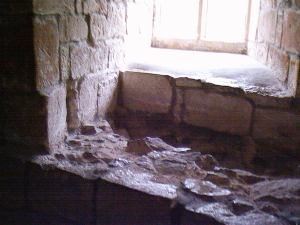
A window in one of the inner curtain towers. The change in masonry thickness is clear. [Enlarge]
Sources:
- Personal visit
- Skipton Castle Guide Book, Jarrold Publishing, Norwich (1999) ISBN 0 7117 1081 3
- A. Pettifer, English Castles: A Guide by Counties, Boydell & Brewer, Woodbridge (1995) ISBN: 0 85115 782 3
- N. Harris, Castles of England, Scotland and Wales, George Philip, London (1991) ISBN: 0 7537 0753 5
- Castles:Knowledge in a Netshell, FAX_PAX, ISBN 1 873147 12 0
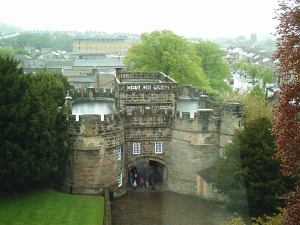
Looking down at the outer gatehouse from the "watch tower" in the inner curtain. [Enlarge]
Photograph Gallery (yet more photos!)